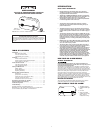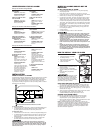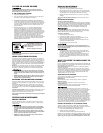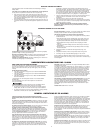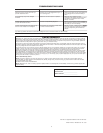
3
IF YOUR CO ALARM SOUNDS
Actuation of your CO Alarm indicates the presence of carbon
monoxide (CO) which can kill you. In other words, when your CO
Alarm sounds, you must not ignore it!
IF THE ALARM SIGNAL SOUNDS:
1. Operate the Test/Silence button.
2. Call your emergency services, fire department or 911. Write down
the number of your local emergency service here:
_____________________________________________________________
3. Immediately move to fresh air—outdoors or by an open door or
window. Do a head count to check that all persons are accounted
for. Do not re-enter the premises, or move away from the open door
or window until the emergency services responder has arrived, the
premises have been aired out, and your CO Alarm remains in its
normal condition.
4. After following steps 1-3, if your CO Alarm reactivates within a
24-hour period, repeat steps 1-3 and call a qualified appliance
technician to investigate for sources of CO from fuel-burning
equipment and appliances, and inspect for proper operation of this
equipment. If problems are identified during this inspection have the
equipment serviced immediately. Note any combustion equipment
not inspected by the technician, and consult the manufacturers’
instructions, or contact the manufacturers directly, for more
information about CO safety and this equipment. Make sure that
motor vehicles are not, and have not, been operating in an attached
garage or adjacent to the residence. Write down the number of a
qualified appliance technician here:
_____________________________________________________________
Alarms have various limitations. See "General Limitations of CO
Alarms" for details.
USING THE SILENCE FEATURES
The Silence Feature is intended to temporarily silence your CO Alarm’s
alarm horn while you correct the problem—it will not correct a CO prob-
lem. While the Alarm is silenced, it will continue to monitor the air for CO.
When CO reaches alarm levels, the Alarm will sound— repeating horn
pattern: 4 beeps, a pause, 4 beeps, etc. Press and hold the Test/Silence
button until the horn is silent. The Silence cycle will last approximately
4 minutes.
NOTE: After 4-minute Silence cycle, the CO Alarm re-evaluates present
CO levels and responds accordingly. If CO levels remain potentially
dangerous—or start rising higher—the horn will start sounding again.
• The Silence Feature is for your convenience only and will not
correct a CO problem. Always check your home for a potential
problem after any alarm. Failure to do so can result in injury or
death.
• NEVER disconnect your CO Alarm to silence the horn. Use the
Silence Feature. Unplugging the CO Alarm and removing the
batteries removes your protection!
SILENCING THE LOW BATTERY WARNING
Pressing the silence button can stop the low battery “chirp” for up to 8
hours; do not remove the battery or unplug the Alarm, unless changing
the battery.
Once the low battery warning “chirp” silence feature is activated, the
unit continues to flash the red light once a minute for 8 hours. After 8
hours, the low battery “chirp” will resume.
Replace the battery as soon
as possible.
To deactivate this feature:
Press the Test/Silence button again. The unit
will go into Test Mode and the low battery warning will resume (LED
flashes and unit sounds “chirp” once a minute.)
If you cannot silence the low battery warning, replace your battery
immediately.
“ALARM-MOVE TO FRESH AIR”
If you hear the alarm horn and the red
light is flashing, move everyone to a
source of fresh air.
DO NOT unplug the CO Alarm!
REGULAR MAINTENANCE
To keep the CO Alarm working properly:
• Test it every week as described in “Weekly Testing.”
• Vacuum the CO Alarm cover at least once a month, using the soft
brush attachment. Never use water, cleaners, or solvents, since they
may damage the unit. Test the Alarm again after vacuuming.
• Replace the battery immediately when you hear the “Low Battery
Warning”.
The Low (or Missing) Battery Warning: The horn will “chirp” once a
minute.
REPLACING THE BATTERY
Choosing a Replacement Battery:
This unit requires one standard 9V alkaline battery. The following alkaline
batteries are acceptable as replacements: Duracell #MN1604 or MX1604;
Eveready “Energizer” 522. You can also use an Ultralife 9 volt lithium bat-
tery #U9VL for longer service life between battery changes. These
replacement batteries are commonly available at local retail stores.
Use only the alkaline or lithium replacement batteries listed. The unit
may not operate properly with other batteries. Never use rechargeable
batteries since they may not provide a constant charge.
To Replace The Battery:
1. Open the battery compartment.
2. Use the thumb guide to remove the old battery.
3. Insert the new battery, making sure it snaps completely into the
battery terminals and cannot be shaken loose.
4. Close the battery compartment, then test the battery back-up by
pressing the Test/Silence button.
5. Plug the CO Alarm back into the outlet.
DO NOT spray cleaning chemicals or insect sprays directly on or
near the CO Alarm. DO NOT paint over the CO Alarm. Doing so may
cause permanent damage.
• Household cleaners, aerosol chemicals and other contaminants
can affect the sensor. When using any of these materials near the
CO Alarm, make sure the room is well ventilated.
• If your home is being fumigated, unplug the unit temporarily and
put it where it will not be exposed to chemicals or fumes. When
fumigation is complete and all traces of fumes clear, plug the unit
back in and retest it.
TESTING AND MAINTENANCE
WEEKLY TESTING
Press the Test/Silence button on the Alarm cover until alarm sounds.
During testing, you will hear a loud alarm sequence – 4 beeps, pause,
4 beeps, pause.
• If the Alarm ever fails to test properly, replace it immediately.
Products under warranty may be returned to the manufacturer
for replacement. See “Limited Warranty” at the end of this
manual.
• DO NOT stand close to the Alarm when the horn is sounding.
Exposure at close range may be harmful to your hearing. When
testing, step away when horn starts sounding.
• NEVER use vehicle exhaust! Exhaust may cause permanent
damage and voids your warranty.
WHAT YOU NEED TO KNOW ABOUT CO
WHAT IS CO?
CO is an invisible, odorless, tasteless gas produced when fossil fuels do
not burn completely, or are exposed to heat (usually fire). Electrical appli-
ances typically do not produce CO.
These fuels include: Wood, coal, charcoal, oil, natural gas, gasoline,
kerosene, and propane.
Common appliances are often sources of CO. If they are not properly
maintained, are improperly ventilated, or malfunction, CO levels can rise
quickly. CO is a real danger now that homes are more energy efficient.
“Air-tight” homes with added insulation, sealed windows, and other
weatherproofing can “trap” CO inside.
SYMPTOMS OF CO POISONING
These symptoms are related to CO POISONING and should be dis-
cussed with ALL household members.
Mild Exposure:
Slight headache, nausea, vomiting, fatigue (“flu-like” symptoms).
Medium Exposure:
Throbbing headache, drowsiness, confusion, fast heart rate.
Extreme Exposure:
Convulsions, unconsciousness, heart and lung failure. Exposure to
carbon monoxide can cause brain damage, death.
This CO Alarm measures exposure to CO over time. It alarms if CO
levels are extremely high in a short period of time, or if CO levels reach a
certain minimum over a long period of time. The CO Alarm generally
sounds an alarm before the onset of symptoms in average, healthy
adults. Why is this important? Because you need to be warned of a
potential CO problem while you can still react in time. In many reported
cases of CO exposure, victims may be aware that they are not feeling
well, but become disoriented and can no longer react well enough to exit
the building or get help. Also, young children and pets may be the first
affected. The average healthy adult might not feel any symptoms when
the CO Alarm sounds. However, people with cardiac or respiratory prob-
lems, infants, unborn babies, pregnant mothers, or elderly people can be
more quickly and severely affected by CO. If you experience even mild
symptoms of CO poisoning, consult your doctor immediately!
FINDING THE SOURCE OF CO AFTER AN ALARM
Carbon monoxide is an odorless, invisible gas, which often makes it
difficult to locate the source of CO after an alarm. These are a few of the
factors that can make it difficult to locate sources of CO:
• House well ventilated before the investigator arrives.
• Problem caused by “backdrafting.”
• Transient CO problem caused by special circumstances.
Because CO may dissipate by the time an investigator arrives, it may be
difficult to locate the source of CO.
BRK Brands, Inc. shall not be obli-
gated to pay for any carbon monoxide investigation or service call.



